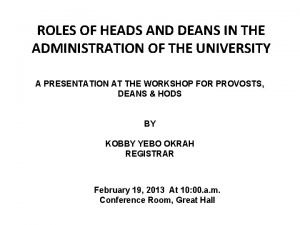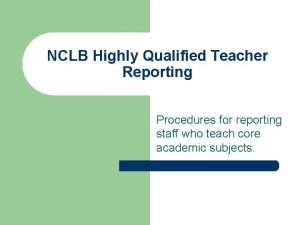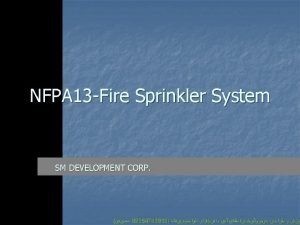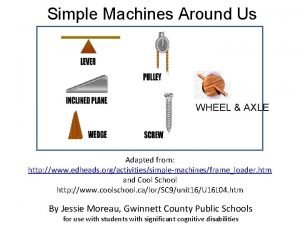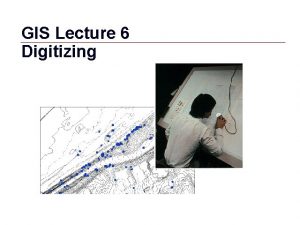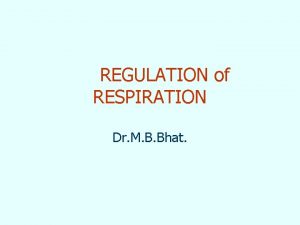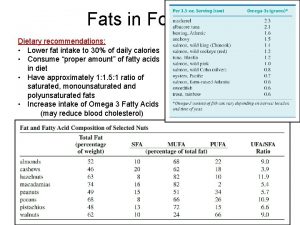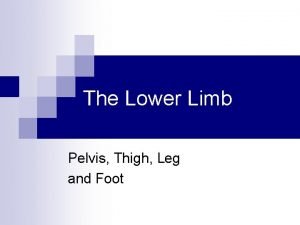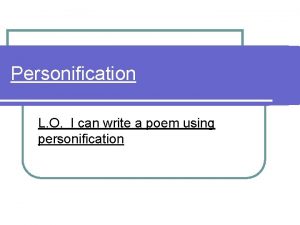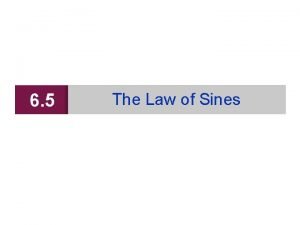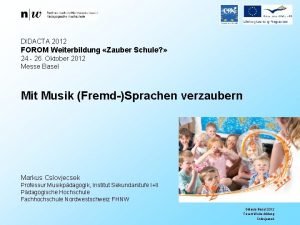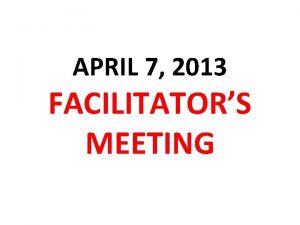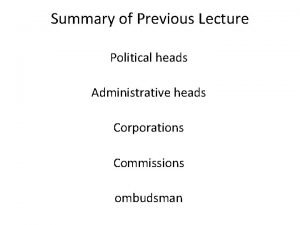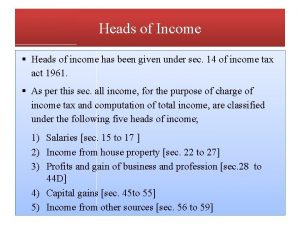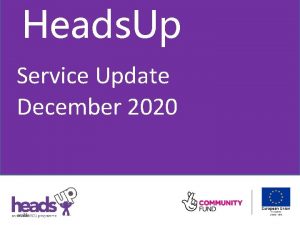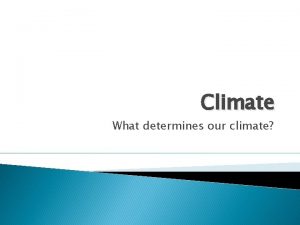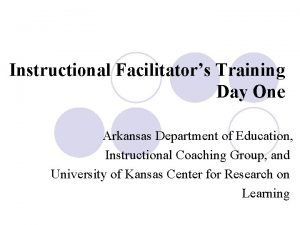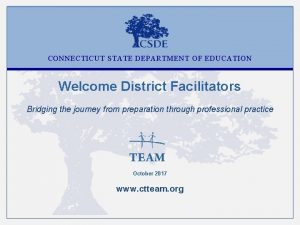Department Heads Climate Workshop 2012 2013 Workshop facilitators



































- Slides: 35

Department Heads Climate Workshop 2012 -2013 Workshop facilitators: Rebecca Brent, Consultant & President, Education Designs, Inc. Betsy Brown, Vice Provost for Faculty Affairs Margo Daub, Head, Plant Biology Marcia Gumpertz, Assistant Vice Provost for Faculty and Staff Diversity Workshop participants Clay Clark, Molecular and Structural Biochemistry Mary Ann Danowitz, Leadership, Policy and Adult and Higher Education Lizette Hardie, Clinical Sciences Brad Kirkman, Management, Innovation, and Entrepreneurship Jeff Mullahey, Crop Science Patricia Simmons, STEM Education

Workshop series started as part of the NCSU “Developing Diverse Departments” grant funded by the NSF ADVANCE Program (Increasing the Participation and Advancement of Women in Academic Science and Engineering Careers) Goals of ADVANCE: • Increase the numbers and advancement of women in STEM disciplines in order to create a more diverse workforce • Address the role for NSF in advancing the status of women in STEM disciplines in academic institutions • Funded programs address academic and institutional structures that may be a barrier to women’s participation and advancement

NCSU ADVANCE Goals • Diversify the professoriate at NCSU • Promote an inclusive climate that promotes the success of all faculty, with an emphasis on women and faculty of color • Increase women in line leadership positions and cultivate men and women leaders as change agents Activities: • groups of scholars that studied leadership and social bias • leadership workshops for mid-level faculty • climate workshops for Dept. Heads

Climate Workshop Series of 4 workshops plus a survey of the climate within departments Development of strategies to create or extend an inclusive departmental climate Goal: assist department heads in creating or extending conditions in their departments that are favorable for advancing faculty including women and minority faculty 2009 – 2012: 4 workshop series involving 25 Department Heads

NC State Faculty: Presence of Women • In Fall 2011 women made up – – – 22% of NCSU tenured faculty, up from 19% in 2006 19% in CALS, up from 16% in 2006 49% in CED, up from 40% in 2006 18% in COM, down from 20% in 2006 24% in CVM, down from 25% in 2006 • Women are higher fraction of not-yet tenured faculty: – 39% at NCSU in fall 2011, 38% in 2006

NC State Faculty: Gender and Risk of Leaving and Tenure Success • Women are at 38% higher risk than men of not being here with tenure after 7 years (1996 -2005 cohorts) – – CALS: 53% (18/34) of women still here, 77% of men CED: 38% (10/26) of women still here, 50% of men COM: 50% (6/12) of women still here, 61% of men CVM: 36% (4/11) of women still here, 56% of men • Tenure success rates: 51/55=93% for women, 83/87=95% for men (2009 -10 to 2011 -12)

NC State Faculty of Color: Presence • Black, Hispanic, American Indian faculty made up 7% (70) of NCSU tenured faculty in 2011, 6% (61) in 2006. – – 3% in CALS, up from 2% in 2006 20% in CED, up from 11% in 2006 10% in COM, also 10% in 2006 7% in CVM, also 7% in 2006 • These groups made up 8% of NCSU not-yet tenured faculty in 2011 (11 black, 11 Hispanic, 1 American Indian), 9% in 2006 (21 black, 5 Hispanic)

NC State Faculty of Color Risk of Leaving and Tenure Success • Black, Hispanic, American Indian NCSU faculty were at 18% higher risk of not being here with tenure after 7 years (1995 -2004 cohorts), compared to other faculty (not statistically significant across all colleges). – – CALS: 63% (5/8) of URM still here, 70% (75/107) of others CED: 30% (3/10) of URM still here, 47% (15/32) of others COM: 50% (2/4) of URM still here, 58% (15/26) of others CVM: 100% (2/2) of women still here, 44% (12/27) of others • Tenure success rates: 9/9=100% URM faculty; 109/116=94% for white faculty (2009 -10 to 2011 -12)

Reference Slides More detailed demographic data are shown in this link and the following slides. NC State Faculty Demographics 1999 -2008: http: //www. ncsu. edu/diversity/outcomes/pdf/ncsufacultygenderandrace 19992008. pdf

COACHE 2011 -12 Survey Who? • Collaborative on Academic Careers in Higher Education Survey (COACHE), administered by the Harvard Graduate School of Education. • Over 75 participating colleges/universities • NC State COACHE peers – – – Clemson University Kansas State University Purdue University SUNY-Albany University of Tennessee • Population: – Pre-tenure and tenured faculty – Non-tenure track faculty (part of pilot study; no COACHE peer comparisons) – Full-time, hired prior to July 1, 2011, not in terminal year after being denied tenure

COACHE 2011 -12 Survey WHY? Purpose: To systematically collect information to help NC State assess (and improve) the quality of work life. Components of the survey: – – – – – Nature of work in research, teaching, and service Resources to support faculty work Tenure and promotion policies and practices Leadership and governance Department collegiality, quality, and engagement Benefits, compensation, and work/life Interdisciplinary work and collaboration Mentoring Appreciation and recognition

COACHE 20011 -12 Survey Response Rates NC State Resps Rate COACHE Peers Resp Pop Resps Rate Pre-Tenure & Tenured Faculty Pop Overall 1, 362 800 59% 5, 113 2, 631 247 145 59% 1, 170 653 1, 115 655 59% 3, 943 1, 978 Associate 426 247 58% 1, 690 856 Full 702 416 59% 2, 300 1, 014 571 56% 348 229 1, 096 264 All COACHE Institutions Resp Pop Resps Rate 51% 27, 660 13, 634 49% 56% Tenure Status Pre-Tenured 7, 772 3, 973 51% 50% 19, 888 9, 661 49% 51% 9, 711 4, 689 48% 1, 138 49% 10, 618 5, 117 48% 3, 588 1, 729 48% 17, 710 8, 151 46% 66% 1, 525 902 59% 5, 483 55% 669 61% 4, 041 2, 159 53% 21, 332 10, 897 51% 130 49% 1, 071 44% 43% Rank Gender Male Female 9, 950 Race/Ethnicity White Faculty of Color 6, 269 2, 725

COACHE 20011 -12 Survey Response Rates NC State Non-Tenure Track Faculty Overall Pop Resp Rate 432 197 46% Male 231 94 44% Female 219 103 47% 370 175 47% 53 22 42% Gender Race/Ethnicty White Faculty of Color

COACHE 2011 -12 Survey Methodology – COACHE items typically ask for ‘agreement’ or ‘satisfaction’ with a particular statement or area of work – COACHE uses a 5 -point response scale – Higher numbers represent more positive or favorable opinions – Reporting on average ratings – “Notable difference” between groups exist when the difference in averages rating is +/- 0. 25. – Within reports for a sub-group, “higher” = 4. 0 and above, “lower” = 2. 75 or below

COACHE 2011 -12 Survey Gender Differences Women gave notably more favorable ratings than men in just a few areas – Personal and family policies • Housing benefits • Tuition waivers, remission, exchange – Mentoring • Effectiveness of mentoring from outside the department / outside the university • Importance of mentoring from outside the department / outside the university Women gave notably less favorable ratings than men on most items, esp. for*: • Promotion and Tenure – Department culture encourages promotion (3. 56 vs 4. 11) – Clarity of promotion process (3. 70 vs 4. 17) – Clarity of time frame for promotion (3. 31 vs 3. 78) – Clarity of promotion criteria (3. 64 vs 4. 04) – Tenure decisions are performance based (3. 44 vs 3. 89) * Items with at least a 0. 40 difference (rather than 0. 25) in average ratings given by women and men

COACHE 2011 -12 Survey Gender Differences cont’d Less favorable results: • Nature of work – Ability to balance teaching/research/service (3. 11 vs 3. 53) – Equity of committee assignments 2. 06 vs 3. 37 • Mentoring/Interdisciplinary Work – Effectiveness of mentoring from outside the institution (3. 99 vs 3. 57) – Support for faculty to be good mentors (2. 06 vs 2. 47) – Interdisciplinary work rewarded in tenure (2. 69 vs 2. 98) • Other – Right balance between professional/personal (3. 02 vs 3. 50) – Colleagues committed to diversity/inclusion (3. 68 vs 4. 08) * Items with at least a 0. 40 difference (rather than 0. 25) in average ratings given by women and men

COACHE 2011 -12 Survey Race/Ethnicity Differences Faculty of color gave notably more favorable ratings than white faculty for – Nature of work • Support for travel to present/conduct research (3. 23 vs 2. 97) • Support for faculty in leadership roles (3. 22 vs 2. 81) • Ability to balance teaching/research/service (3. 66 vs 3. 36) – Interdisciplinary work • Interdisciplinary work is rewarded in tenure (3. 11 vs 2. 80) – Tenure policies, clarity, reasonableness • Clarity of body of evidence for deciding tenure (4. 00 vs 3. 70) • Clarity of expectations: advisor (3. 56 vs 3. 23)

COACHE 2011 -12 Survey Race/Ethnicity Differences Faculty of color gave notably less favorable ratings than white faculty for: • • • Promotion: Clarity of – Promotion process (3. 81 vs 4. 09) – Promotion criteria (3. 68 vs 3. 99) – Promotion standards (3. 41 vs 3. 68) – Time frame for promotion (3. 39 vs 3. 71) – Whether I will be promoted (3. 08 vs 3. 34) Overall satisfaction – Visible leadership for support of diversity/inclusion (3. 44 vs 4. 05) – I would again choose this institution (3. 51 vs 3. 76) Department collegiality, engagement, and quality – Colleagues are committed to diversity/inclusion (3. 58 vs 4. 03) – Department is successful at faculty retention (3. 21 vs 3. 49) Personal and family policies – Stop-the-clock policies (3. 42 vs 3. 71) – Salary (2. 48 vs 2. 83) Collaboration – Opportunities for collaboration within the department (3. 42 vs 3. 84)

Non-Tenure Track Faculty: Compared to Tenure Track Faculty (Pre-tenure/Tenured Combined) • NTT faculty gave notably more favorable ratings than pre-tenure & tenured faculty for many (most) items, especially those related to…. – – Nature of work: Support for research, teaching, etc. Personal and family policies (including balance, flexible workload/duties, ) Health and retirement benefits Leadership and governance NTTs gave notably less favorable ratings than pre-tenure & tenured faculty for: • Department life – Amount of professional interaction with tenured faculty (3. 36 vs 3. 76) – How well you fit (3. 28 vs 3. 67) – Amount of professional interaction with pre-tenure faculty (3. 43 vs 3. 82) – Amount of person interaction have w/ pre-tenure faculty (3. 34 vs 3. 64)

Non-Tenure Track Faculty: Compared to Tenure Track Faculty (Pre-tenure/Tenured Combined) Less favorable ratings • Appreciation and recognition – Recognition for scholarship (3. 16 vs 3. 41) • Nature of work – Influence over focus of research (3. 99 vs 4. 34) • Collaboration – Opportunities for collaboration outside the institution (3. 39 vs 3. 86) • Mentoring – Effectiveness of mentoring from outside the institution (3. 44 vs 3. 70)

Implications for Department Climate? • Different groups as well as individuals experience the department differently • Need to be attuned to these differences • Head/department may need to address the same issues in different ways in response to range of responses • Associate professors more dissatisfied than professors, esp. on issues of workload, balance, promotion

What is Climate? Campus Climate: Behaviors within a workplace or learning environment, ranging from subtle to cumulative to dramatic, that can influence whether an individual feels personally safe, listened to, valued, and treated fairly and with respect. University of Wisconsin WISELI Program http: //wiseli. engr. wisc. edu

Importance of Climate Chronicle of Higher Education, Sept. 28, 2006: “Young Ph. D. ’s Say Collegiality Matters More Than Salary” http: //chronicle. com/article/Young-Ph. D-s-Say/4178 Harvard Graduate School of Education/COACHE survey: Tenure-track faculty rate collegiality and department climate as more important than salary, workload, or “tenure clarity” Contrasts with past generations that valued autonomy as most important Coache survey: Climate is 5 times as important as compensation in predicting job satisfaction

Importance of Climate Research documents that department climate influences: • Satisfaction, effectiveness, and engagement • Productivity • Success and advancement of faculty • Decision to stay or leave a department In academic environments, central role for faculty governance means that faculty values and behavior dominate workplace and shape careers Experience of climate differs for faculty from underrepresented groups: • more likely to experience bias, lack of role models, discrimination and harassment • women faculty experience greater work-life balance issues, especially early in their careers

Addressing Climate Problems • Become aware of climate problems (this workshop) • Promote respect/consideration/manners • Build departmental structures that promote inclusiveness • Recognize contributions of faculty and staff • Develop an effective communication style • Listen and be sensitive to department members’ concerns • Address illegal behaviors

Climate Workshop • Addresses the NCSU ADVANCE program goal of increasing the number of department heads who are actively and effectively creating conditions within their units that are favorable for advancing women and minority faculty • Focuses on: surveying the climate within departments developing and implementing strategies for creating or extending an inclusive departmental climate • Based on a model and survey developed by the University of Wisconsin ADVANCE grant WISELI (Women in Science and Engineering Leadership Institute) program NC STATE UNIVERSITY

2009 -2012 Department Head Climate Workshops • Workshops plus climate survey of departmental faculty and staff • 25 departments (1235 faculty & staff surveyed, 913 responses, 74% response rate): Agriculture & Life Sciences (5) Engineering (2) Education (2) Humanities and Social Sciences (3) Management (2) Natural Resources (2) PAMS (5) Textiles (2) Veterinary Medicine (2) • Results compiled by outside consultant; provided only to department head • Final workshop focused on strategies for addressing climate issues identified in survey NC STATE UNIVERSITY

Survey Response Rate Overall Faculty Staff Surveys Sent 1235 829 406 Responses Response Rate 913 74% 625 75% 288 71%

Rate the climate in your department. Composite of all 25 depts. Fac. N=625 Staff N=288 Fac. N=29 Staff N=9 Lowest-rated department Fac. N=28 Staff N=5 Highest-rated department

Examples of Survey Statements (strongly agree to strongly disagree) • Head of my department respects my opinions and contributions • I understand my role and responsibilities as an employee in the department • My work is commensurate with my training and experience • My department is a welcoming place to work • I am happy with the professional relationships I’ve formed with others in the dept. • I feel appreciated for the work I do in my department • I feel reasonably accommodated when personal and professional responsibilities conflict • My department colleagues recognize how my work contributes to the dept. mission NC STATE UNIVERSITY

Open-ended Questions • List 3 aspects of the department that contribute to a positive climate • List 3 aspects of the department that contribute to a negative climate • What are your expectations of your department head? • List 3 things the department head can do to improve the climate in the department • List 3 things you can do to improve the climate in the department NC STATE UNIVERSITY

Survey Results Examples of Contributors to Positive Climate • Department having atmosphere of collegiality and respect • Shared goals and vision • Having strong and fair leadership • Feeling that input and contributions are recognized and appreciated • Having a diverse department (age, ethnicity, scholarly and educational background) • Strong academic and research environment and opportunities • Members who do their jobs • Social events • For staff: flexible supervisors NC STATE UNIVERSITY

Survey Results Examples of Contributors to Negative Climate • Lack of adequate budgets and facilities • Frustrations with higher administration • Inadequate opportunity for faculty and staff to be involved in decision making and planning • A sense of “in” vs. “out” groups/dominance of key personnel • Negativity • Feelings of isolation by and need for better communication with staff • Insufficient opportunities and dedicated space for informal interactions NC STATE UNIVERSITY

Some Initiatives from Specific Departments in Response to Survey Results • Setting up committees for on-going discussion and recommendations for department vision and future directions • Identifying space/funds for break room to facilitate informal interactions • Appointed group to plan family-friendly social events • Setting up Facebook page and departmental newsletter for better communication NC STATE UNIVERSITY

Some Initiatives from Specific Departments in Response to Survey Results, cont. • Appointment of staff to some departmental committees • Dept. Head setting aside time to talk with faculty and staff • Scheduling regular discussions at department meetings about diversity and climate issues • Seeking out faculty and staff for important initiatives rather than relying on volunteers NC STATE UNIVERSITY
 Vmpi virginia
Vmpi virginia Structure of the advertising industry
Structure of the advertising industry External facilitators advertising
External facilitators advertising Climate change 2014 mitigation of climate change
Climate change 2014 mitigation of climate change Department of labor employment workshop
Department of labor employment workshop The snake chief background
The snake chief background 9 headed monster
9 headed monster Heads up tackling circuit
Heads up tackling circuit Cc: all deans and heads
Cc: all deans and heads Technical assistance plan
Technical assistance plan Sprinkler head color coding
Sprinkler head color coding Heads up academy
Heads up academy Wheel and axle examples around the house
Wheel and axle examples around the house Heads down digitizing
Heads down digitizing Income tax slabs
Income tax slabs Easter island and stonehenge
Easter island and stonehenge Hering breuer reflex
Hering breuer reflex The silver thorn of bloody rose meaning
The silver thorn of bloody rose meaning The movement of radial arm is mcq
The movement of radial arm is mcq Types of screw heads
Types of screw heads Simile personification metaphor alliteration
Simile personification metaphor alliteration Hydrophilic heads
Hydrophilic heads Slidetodoc. com
Slidetodoc. com House personification
House personification A motorboat heads due east at 16 m/s
A motorboat heads due east at 16 m/s Daimyo were heads of noble families who
Daimyo were heads of noble families who Heads up tackling
Heads up tackling Hse growth chart boy
Hse growth chart boy A pilot sets out from an airport and heads in the direction
A pilot sets out from an airport and heads in the direction Hydrophilic heads
Hydrophilic heads Running head example
Running head example Coconut man, moonheads and pea
Coconut man, moonheads and pea Hydrophilic heads
Hydrophilic heads Dr ramona raya
Dr ramona raya Cvpr 2012
Cvpr 2012 Didacta 2012
Didacta 2012








